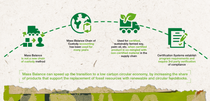Media
Mass balance: turning everyday products into a more sustainable version
A not-so-new solution, mass balance allows BASF to reduce fossil resources without compromising the quality of the products.
As a global leader in the chemical industry, BASF operates across diverse sectors, touching consumers' daily lives in countless ways. Our products have various applications, from the building materials of your home to the car you drive, and even the personal care items you use.
To meet our corporate purpose of creating chemistry for a sustainable future, we've embarked on a transformative journey throughout our entire value chain. A pivotal strategy in this endeavor is the application of the mass balance approach.
Mass balance is not a new approach, but an effective one that is currently used across many different industries that are transitioning to more circular and sustainable solutions. Organizations such as FairTrade International, UTZ or the Better Cotton Initiative, for example, work with companies that manufacture products with raw materials from both certified and uncertified sources.

What is the mass balance approach and how is BASF applying it?
Driving a circular economy is one of our main priorities at BASF, and circular feedstocks (or chemical raw materials) are one of the key areas where we are implementing more sustainable solutions. This is where the mass balance approach comes in.
Essentially, the mass balance approach is one of the ways BASF can incorporate renewable and/or recycled feedstock into a complex chemical production chain, accelerating the transition away from fossil raw materials without compromising the performance of the products.
Recycled or renewable feedstock is added at the beginning of the complex and integrated production process. Recycled feedstock is obtained through chemical recycling. Our partners recycle plastic waste and products such as end-of-life tires to obtain raw materials, like pyrolysis oil, that can later be used to substitute fossil feedstocks like naphtha in manufacturing new, high-quality products. Renewable or biogenic feedstocks, on the other hand, are obtained from biomass, which is organic material that comes from plants and animals. From this biomass, we can produce bio-naphtha or biogas, which can later be introduced into the production chain to substitute naphtha or natural gas.
There are some very significant benefits to using this approach:
- It helps to divert plastic waste from incineration or landfill, while also increasing recycle rates.
- It can substitute raw material obtained from fossil sources.
- It does not compromise the quality or the properties of the product. They remain identical.
- There is no need to adapt the formulation of the customer’s product, the infrastructure, the equipment or the processes already in place, so no additional time and effort is needed to switch from the conventional to the mass-balanced product.
- It may offer a lower product carbon footprint compared to the conventional product.
Mass balance products not only bring BASF closer to our goal of implementing a circular economy, they also help our customers meet their own sustainability goals by incorporating them into their own production process.
To learn more about mass balance and the production process, watch the following video:
How does mass balance affect customers?
As noted, by creating products that support the use of recycled feedstock, we are avoiding greenhouse gas emissions generated by incinerating plastic waste and reducing the need to use crude-oil based naphtha or natural gas in the manufacturing of these products.
In the case of substituting fossil feedstock with bio-based feedstocks like bio-naphtha or biogas, one benefit may come from the amount of greenhouse gas (carbon dioxide) already absorbed in the biomass during its growth.
In an effort to continuously reduce the product carbon footprint (PCF) of our products, we calculate the PCF of our entire portfolio, from the moment raw materials are extracted (cradle) until they leave the BASF site (gate), so that our customers understand how BASF materials contribute positively to their company’s carbon footprint.
By incorporating mass-balanced products, we are also helping our customers reach their own sustainability targets.
When our customers purchase mass-balance products with a reduced carbon footprint compared to the conventional product, they are supporting the substitution of fossil feedstocks and contributing to a circular economy within their value chain.
There are many examples of collaborations with customers who purchase mass balance products from BASF:
Steelcase’s Flex Perch Stool is made out of BASF’s Ultramid® B3EG6 Ccycled®, a polyamide created from material from a waste stream and obtained through chemical recycling.
Mercedes Benz also incorporated mass-balanced Ultramid® in the bow door handle of the S-Class and EQE models.
Henkel has committed to reducing the fossil carbon feedstocks in its European Laundry & Home Care, and Beauty Care products by incorporating BASF mass balance products.

A step in the right direction
Fostering a circular economy is key to making the most of the limited resources on our planet, minimizing waste and incorporating renewable resources, creating value. By 2030, we aim to double sales from circular economy solutions to €17 billion ($18 billion).
We are taking action and advancing in different directions, from finding alternative feedstocks to helping our processes become even more efficient by incorporating new, cleaner technologies, and everything in between.
Our efforts span across different sectors and disciplines. We have our most creative and innovative minds working to get us there and there is much more to come. Stay tuned.
Published on November 20, 2023, by Mariana Licio.
For media inquiries or to repurpose this article, please contact Lisa Brown.